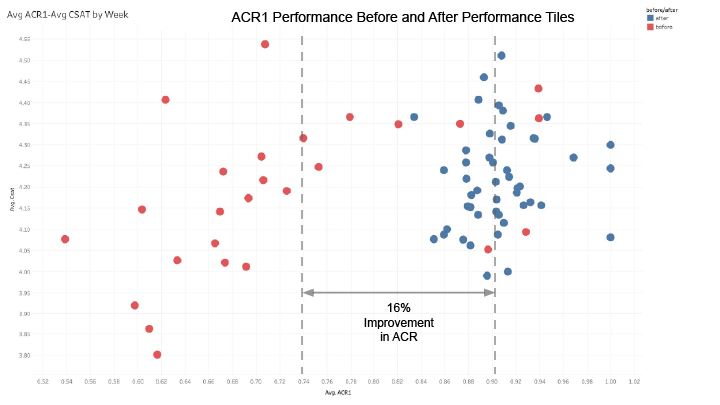
Is It Time to Re-Evaluate First Contact Resolution?
Over the past decade, contact center leaders put an increasing amount of attention on First Call Resolution. Some leaders deem it the metric that matters most for call centers to watch.
So, organizations buy into the advice and push their agents to improve FCR.
And in theory, it is a super valuable metric. The goal of customer service is to solve a customer’s issue on the first contact. But there are a few problems with the traditional FCR metric that we think are worth talking about. Let’s challenge the status quo and walk through common roadblocks with First Call Resolution. Then, let’s talk about how we can shake up the traditional metric to better fit the needs of your contact center and customers.
>> Learn More: How Centricity reduced callbacks to their contact center by 16%
What’s Wrong with First Call Resolution?
1. FCR can be difficult to define & calculate
FCR is an organizational metric that looks at the overall efficiency and effectiveness of your contact center. But similar to CSAT, it can be tough to measure something with such a broad impact in your contact center. Ask a dozen companies how they measure FCR and you might hear a dozen different answers.
It’s common to ask customers a question to measure FCR. Your agents follow up after an interaction and ask a customer, “have I fully resolved your issue today?” Only your customers who want to volunteer their time answer the question, leaving you with anecdotal data. Plus, you have to think through all the scenarios that might pop up for your customers, too. How long do you wait for a customer to call back after marking their issues as resolved? And does transferring a call or switching channels still count as a single interaction?
2. FCR is out of an agent’s control
Your agents can’t control what happened in a customer’s past interaction history with your company. Measuring your agents on first contact resolution penalizes agents who help customers on their second contact or their third, even if it’s that agent’s first time talking to the customer.
Let’s say your agent Jenni handles an interaction with a customer on Tuesday. Jenni does her best to the solve problem, wraps up the interaction, and sends the customer on her way. Then on Friday, the same customer calls back and gets patched through to a different agent, Brennan. Brennan’s FCR suffers because he’s helping the customer through her second interaction, not her first. Even though the initial interaction was entirely out of Brennan’s control. When your agents don’t feel in control of their metrics and success, they’ll disengage and stop delivering the best service they can.
>> Read Next: What is First Contact Resolution compared to Active Contact Resolution?
3. FCR isn’t always possible
Today’s customers are complicated. And their needs change all the time. They have tough issues to solve, and often, by the time they call you, they’ve tried everything in their power to fix it. Your agents get to tackle these tough issues, and sometimes coming up with a lasting resolution means hanging up and problem-solving offline for the customer. Let’s be clear: finding a long-term resolution instead of a fast one doesn’t mean your agent’s doing a bad job. In fact, it means they’re working hard to eliminate future issues and keep your customers happy – even if it means a few phone calls in the short term.
How to Approach FCR in Your Contact Center (Use ACR Instead!)
Rattling off issues with a popular contact center metric without sharing a solution wouldn’t make us a good vendor partner now, would it? Our team here at Sharpen ruminated on how to improve FCR and how to make it easier to measure. Now, we advocate for a metric that’s native to the Shapen platform, called Active Contact Resolution (ACR).
Active Contact Resolution measures the percentages of an agent’s interactions that don’t require a callback within a given time frame, like 1, 3, or 7 days.
It measures each agent on their ability to solve the problem during their own interaction rather than gauging performance on a customer’s entire interaction history (potentially with a bunch of other agents). If your agent’s ACR sits at 80%, it means 8 out of 10 customers didn’t have to call back for help after talking to that specific agent.
You score agents on their percentage of successful interactions. ACR is a metric your agents can control. And when your agents feel in control, they work harder to deliver better service. We have proof.
A Sharpen Customer Measured and Coached on ACR and Reduced Callbacks by 16%

Centricity, one of our customers here at Sharpen, worked with our data science team to choose three, agent-controllable metrics to improve using Sharpen Performance Tiles. They picked ACR as one of the three (in addition to CSAT).
Since measuring ACR and coaching agents to focus on callbacks, Centricity reduced callbacks to their contact center by 16%. What’s more? As ACR improves in their contact center, so does CSAT. Centricity’s team also improved CSAT by 15%. Customers call back less often and say they’re happier with the experience they get.
Because of the positive results, contact center leaders plan to bonus agents based on their ACR percentage, tying better pay and quality of life to factors in their control.
We originally wrote this post on July 5, 2017, and we updated it for new insight on November 4, 2021.


